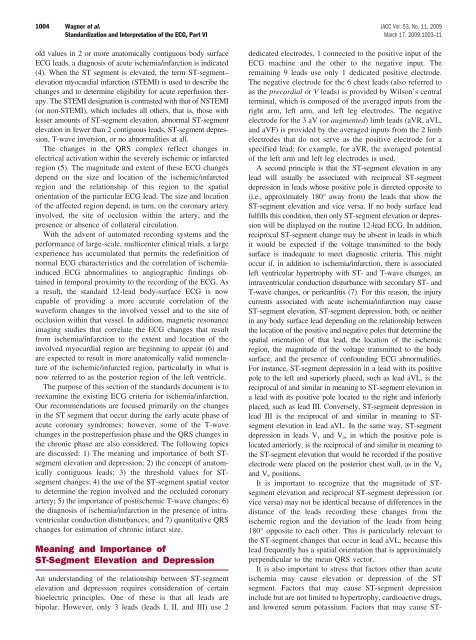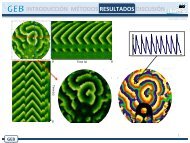1-s2.0-S0735109708041387-main
You also want an ePaper? Increase the reach of your titles
YUMPU automatically turns print PDFs into web optimized ePapers that Google loves.
1004 Wagner et al. JACC Vol. 53, No. 11, 2009<br />
Standardization and Interpretation of the ECG, Part VI March 17, 2009:1003–11<br />
old values in 2 or more anatomically contiguous body surface<br />
ECG leads, a diagnosis of acute ischemia/infarction is indicated<br />
(4). When the ST segment is elevated, the term ST-segment–<br />
elevation myocardial infarction (STEMI) is used to describe the<br />
changes and to determine eligibility for acute reperfusion therapy.<br />
The STEMI designation is contrasted with that of NSTEMI<br />
(or non-STEMI), which includes all others, that is, those with<br />
lesser amounts of ST-segment elevation, abnormal ST-segment<br />
elevation in fewer than 2 contiguous leads, ST-segment depression,<br />
T-wave inversion, or no abnormalities at all.<br />
The changes in the QRS complex reflect changes in<br />
electrical activation within the severely ischemic or infarcted<br />
region (5). The magnitude and extent of these ECG changes<br />
depend on the size and location of the ischemic/infarcted<br />
region and the relationship of this region to the spatial<br />
orientation of the particular ECG lead. The size and location<br />
of the affected region depend, in turn, on the coronary artery<br />
involved, the site of occlusion within the artery, and the<br />
presence or absence of collateral circulation.<br />
With the advent of automated recording systems and the<br />
performance of large-scale, multicenter clinical trials, a large<br />
experience has accumulated that permits the redefinition of<br />
normal ECG characteristics and the correlation of ischemiainduced<br />
ECG abnormalities to angiographic findings obtained<br />
in temporal proximity to the recording of the ECG. As<br />
a result, the standard 12-lead body-surface ECG is now<br />
capable of providing a more accurate correlation of the<br />
waveform changes to the involved vessel and to the site of<br />
occlusion within that vessel. In addition, magnetic resonance<br />
imaging studies that correlate the ECG changes that result<br />
from ischemia/infarction to the extent and location of the<br />
involved myocardial region are beginning to appear (6) and<br />
are expected to result in more anatomically valid nomenclature<br />
of the ischemic/infarcted region, particularly in what is<br />
now referred to as the posterior region of the left ventricle.<br />
The purpose of this section of the standards document is to<br />
reexamine the existing ECG criteria for ischemia/infarction.<br />
Our recommendations are focused primarily on the changes<br />
in the ST segment that occur during the early acute phase of<br />
acute coronary syndromes; however, some of the T-wave<br />
changes in the postreperfusion phase and the QRS changes in<br />
the chronic phase are also considered. The following topics<br />
are discussed: 1) The meaning and importance of both STsegment<br />
elevation and depression; 2) the concept of anatomically<br />
contiguous leads; 3) the threshold values for STsegment<br />
changes; 4) the use of the ST-segment spatial vector<br />
to determine the region involved and the occluded coronary<br />
artery; 5) the importance of postischemic T-wave changes; 6)<br />
the diagnosis of ischemia/infarction in the presence of intraventricular<br />
conduction disturbances; and 7) quantitative QRS<br />
changes for estimation of chronic infarct size.<br />
Meaning and Importance of<br />
ST-Segment Elevation and Depression<br />
An understanding of the relationship between ST-segment<br />
elevation and depression requires consideration of certain<br />
bioelectric principles. One of these is that all leads are<br />
bipolar. However, only 3 leads (leads I, II, and III) use 2<br />
dedicated electrodes, 1 connected to the positive input of the<br />
ECG machine and the other to the negative input. The<br />
re<strong>main</strong>ing 9 leads use only 1 dedicated positive electrode.<br />
The negative electrode for the 6 chest leads (also referred to<br />
as the precordial or V leads) is provided by Wilson’s central<br />
terminal, which is composed of the averaged inputs from the<br />
right arm, left arm, and left leg electrodes. The negative<br />
electrode for the 3 aV (or augmented) limb leads (aVR, aVL,<br />
and aVF) is provided by the averaged inputs from the 2 limb<br />
electrodes that do not serve as the positive electrode for a<br />
specified lead; for example, for aVR, the averaged potential<br />
of the left arm and left leg electrodes is used.<br />
A second principle is that the ST-segment elevation in any<br />
lead will usually be associated with reciprocal ST-segment<br />
depression in leads whose positive pole is directed opposite to<br />
(i.e., approximately 180° away from) the leads that show the<br />
ST-segment elevation and vice versa. If no body surface lead<br />
fulfills this condition, then only ST-segment elevation or depression<br />
will be displayed on the routine 12-lead ECG. In addition,<br />
reciprocal ST-segment change may be absent in leads in which<br />
it would be expected if the voltage transmitted to the body<br />
surface is inadequate to meet diagnostic criteria. This might<br />
occur if, in addition to ischemia/infarction, there is associated<br />
left ventricular hypertrophy with ST- and T-wave changes, an<br />
intraventricular conduction disturbance with secondary ST- and<br />
T-wave changes, or pericarditis (7). For this reason, the injury<br />
currents associated with acute ischemia/infarction may cause<br />
ST-segment elevation, ST-segment depression, both, or neither<br />
in any body surface lead depending on the relationship between<br />
the location of the positive and negative poles that determine the<br />
spatial orientation of that lead, the location of the ischemic<br />
region, the magnitude of the voltage transmitted to the body<br />
surface, and the presence of confounding ECG abnormalities.<br />
For instance, ST-segment depression in a lead with its positive<br />
pole to the left and superiorly placed, such as lead aVL, is the<br />
reciprocal of and similar in meaning to ST-segment elevation in<br />
a lead with its positive pole located to the right and inferiorly<br />
placed, such as lead III. Conversely, ST-segment depression in<br />
lead III is the reciprocal of and similar in meaning to STsegment<br />
elevation in lead aVL. In the same way, ST-segment<br />
depression in leads V 1 and V 2 , in which the positive pole is<br />
located anteriorly, is the reciprocal of and similar in meaning to<br />
the ST-segment elevation that would be recorded if the positive<br />
electrode were placed on the posterior chest wall, as in the V 8<br />
and V 9 positions.<br />
It is important to recognize that the magnitude of STsegment<br />
elevation and reciprocal ST-segment depression (or<br />
vice versa) may not be identical because of differences in the<br />
distance of the leads recording these changes from the<br />
ischemic region and the deviation of the leads from being<br />
180° opposite to each other. This is particularly relevant to<br />
the ST-segment changes that occur in lead aVL, because this<br />
lead frequently has a spatial orientation that is approximately<br />
perpendicular to the mean QRS vector.<br />
It is also important to stress that factors other than acute<br />
ischemia may cause elevation or depression of the ST<br />
segment. Factors that may cause ST-segment depression<br />
include but are not limited to hypertrophy, cardioactive drugs,<br />
and lowered serum potassium. Factors that may cause ST-



